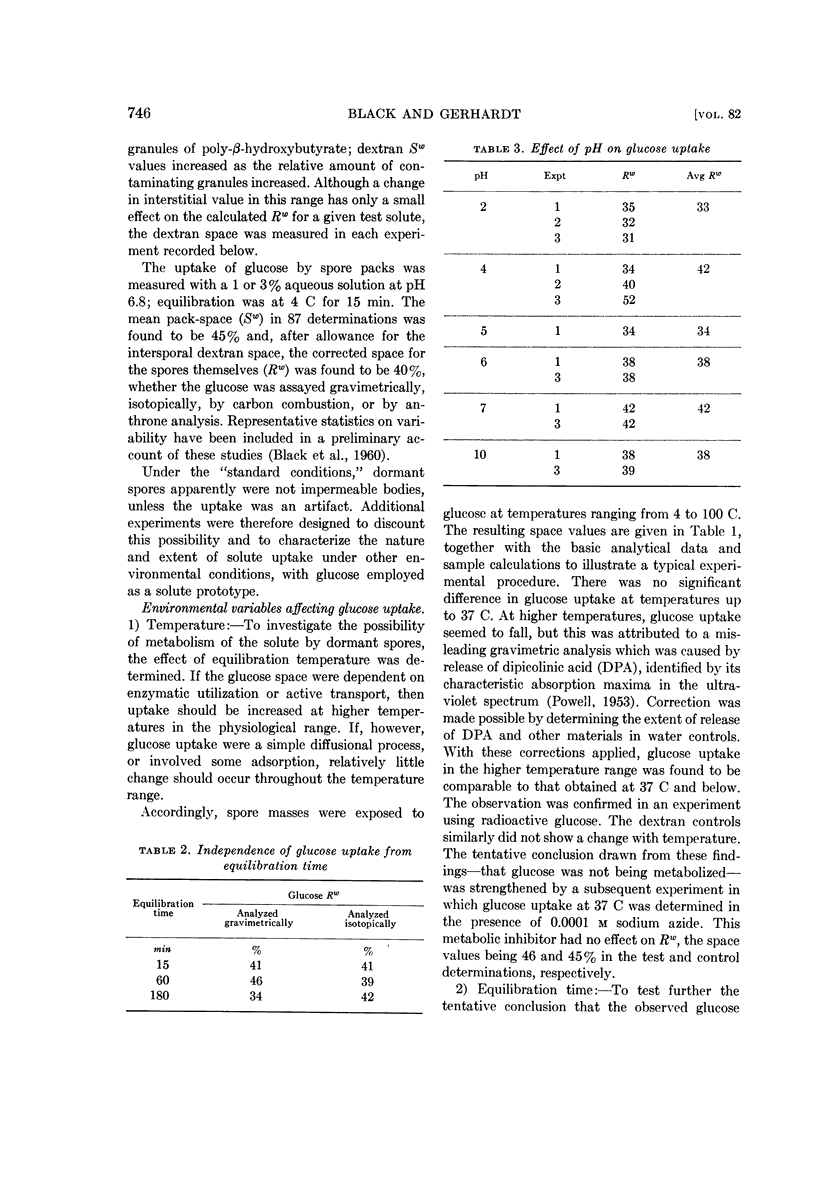Abstract
Black, S. H. (The University of Michigan, Ann Arbor) and Philipp Gerhardt. Permeability of bacterial spores. I. Characterization of glucose uptake. J. Bacteriol. 82:743–749. 1961.—The total uptake of glucose by masses of clean, dormant spores was measured to assess their permeability. After correction for intercellular space, packed spores of Bacillus cereus strain terminalis were found in 87 determinations to be permeated by glucose to 40% of their weight. The glucose uptake was relatively independent of environmental variables, and thus was concluded to occur principally through a process of passive diffusion.
Full text
PDF






Selected References
These references are in PubMed. This may not be the complete list of references from this article.
- BOYLES W. A., LINCOLN R. E. Separation and concentration of bacterial spores and vegetative cells by foam flotation. Appl Microbiol. 1958 Sep;6(5):327–334. doi: 10.1128/am.6.5.327-334.1958. [DOI] [PMC free article] [PubMed] [Google Scholar]
- CONWAY E. J., DOWNEY M. An outer metabolic region of the yeast cell. Biochem J. 1950 Sep;47(3):347–355. doi: 10.1042/bj0470347. [DOI] [PMC free article] [PubMed] [Google Scholar]
- GERHARDT P., BLACK S. H. Permeability of bacterial spores. II. Molecular variables affecting solute permeation. J Bacteriol. 1961 Nov;82:750–760. doi: 10.1128/jb.82.5.750-760.1961. [DOI] [PMC free article] [PubMed] [Google Scholar]
- Gaudin A. M., Mular A. L., O'connor R. F. Separation of Microorganisms by Flotation: II. Flotation of Spores of Bacillus subtilis var. niger. Appl Microbiol. 1960 Mar;8(2):91–97. doi: 10.1128/am.8.2.91-97.1960. [DOI] [PMC free article] [PubMed] [Google Scholar]
- HASHIMOTO T., BLACK S. H., GERHARDT P. Development of fine structure, thermostability, and dipicolinate during sporogenesis in a bacillus. Can J Microbiol. 1960 Apr;6:203–212. doi: 10.1139/m60-022. [DOI] [PubMed] [Google Scholar]
- Lewis J. C., Snell N. S., Burr H. K. Water Permeability of Bacterial Spores and the Concept of a Contractile Cortex. Science. 1960 Aug 26;132(3426):544–545. doi: 10.1126/science.132.3426.544. [DOI] [PubMed] [Google Scholar]
- MACDONALD R. E., GERHARDT P. Bacterial permeability: the uptake and oxidation of citrate by Escherichia coli. Can J Microbiol. 1958 Apr;4(2):109–124. doi: 10.1139/m58-013. [DOI] [PubMed] [Google Scholar]
- Morris D. L. Quantitative Determination of Carbohydrates With Dreywood's Anthrone Reagent. Science. 1948 Mar 5;107(2775):254–255. doi: 10.1126/science.107.2775.254. [DOI] [PubMed] [Google Scholar]
- POWELL J. F. Isolation of dipicolinic acid (pyridine-2:6-dicarboxylic acid) from spores of Bacillus megatherium. Biochem J. 1953 May;54(2):210–211. doi: 10.1042/bj0540210. [DOI] [PMC free article] [PubMed] [Google Scholar]
- ROTHSTEIN A. Role of the cell membrane in the metabolism of inorganic electrolytes by microorganisms. Bacteriol Rev. 1959 Dec;23(4):175–201. doi: 10.1128/br.23.4.175-201.1959. [DOI] [PMC free article] [PubMed] [Google Scholar]


